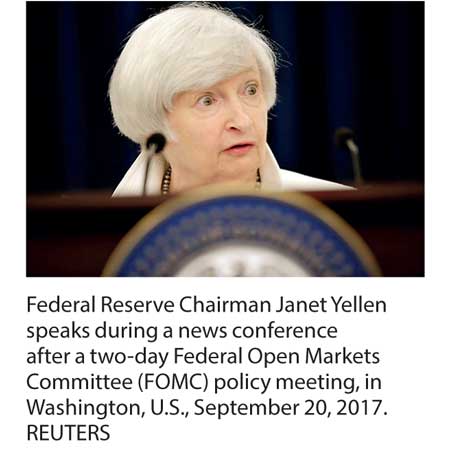Thursday Mar 06, 2025
Thursday Mar 06, 2025
Friday, 22 September 2017 00:00 - - {{hitsCtrl.values.hits}}
 WASHINGTON (Reuters): The US Federal Reserve left interest rates unchanged on Wednesday but signalled it still expects one more increase by the end of the year despite a recent bout of low inflation.
WASHINGTON (Reuters): The US Federal Reserve left interest rates unchanged on Wednesday but signalled it still expects one more increase by the end of the year despite a recent bout of low inflation.
The Fed, as expected, also said it would begin in October to reduce its approximately $4.2 trillion in holdings of US Treasury bonds and mortgage-backed securities acquired in the years after the 2008 financial crisis.
New economic projections released after the Fed’s two-day policy meeting showed 11 of 16 officials see the “appropriate” level for the federal funds rate, the central bank’s benchmark interest rate, to be in a range between 1.25% and 1.50% by the end of 2017, or 0.25 percentage points above the current level.
US bond yields rose, pushing up the US dollar after the Fed’s decision, but US benchmark stock indexes were little changed.
US benchmark 10-year Treasury note yields rose as far as 2.29%, the highest since Aug. 8., a move which helped push bank stock prices higher also.
In its policy statement, the Fed cited low unemployment, growth in business investment, and an economic expansion that has been moderate but durable this year as justifying it’s decision. It added that the near-term risks to the economic outlook remained “roughly balanced” but said it was “closely” watching inflation.
Fed Chair Janet Yellen said in a press conference after the end of the meeting that the fall in inflation this year remained a mystery, adding that the central bank was ready to change the interest rate outlook if needed.
“What we need to figure out is whether the factors that have lowered inflation are likely to prove persistent,” she said. If they do, “it would require an alteration of monetary policy,” Yellen said.
While the interest rate outlook for next year remained largely unchanged in the Fed’s latest projections, with three rises envisioned in 2018, the US central bank did slow the pace of anticipated monetary tightening expected thereafter.
It forecasts only two increases in 2019 and one in 2020. It also lowered again its estimated long-term “neutral” interest rate from 3.0% to 2.75%, reflecting concerns about overall economic vitality.
The US Federal Reserve will resume rate hikes in December and raise borrowing costs three more times in 2018, a Reuters poll found on Wednesday.
The US central bank will also reduce the size of its asset stock pile by about $1.4 trillion over the next several years as it seeks to restore a normal environment for monetary policy, according to the poll of Wall Street’s top banks taken after the Fed’s latest policy meeting, which ended on Wednesday.
The Fed, as expected, also said it would begin in October to reduce its approximately $4.2 trillion in holdings of US Treasury bonds and mortgage-backed securities by initially cutting up to $10 billion each month from the amount of maturing securities it reinvests.
That action will start a gradual reversal of the three rounds of quantitative easing, or bond buying, the Fed pursued between 2008 and 2014 to stimulate economic growth after the 2007-2009 financial crisis and recession.
The limit on reinvestment is scheduled to increase by $10 billion every three months to a maximum of $50 billion per month until the central bank’s overall balance sheet falls by perhaps $1 trillion or more in the coming years.
Yellen said it would take “a material deterioration” in the economy’s performance for the Fed to reverse a schedule that she expects to proceed “gradually and predictably.”
The Fed noted that the recent hurricanes in the United States would affect economic activity but are “unlikely to materially alter the course of the national economy over the medium term.”
Forecasts for economic growth and unemployment into 2018 and beyond were largely unchanged. Gross domestic product is now expected to grow at a rate of 2.4% this year, 2.1% next year and 2.0% in 2019.
Discover Kapruka, the leading online shopping platform in Sri Lanka, where you can conveniently send Gifts and Flowers to your loved ones for any event including Valentine ’s Day. Explore a wide range of popular Shopping Categories on Kapruka, including Toys, Groceries, Electronics, Birthday Cakes, Fruits, Chocolates, Flower Bouquets, Clothing, Watches, Lingerie, Gift Sets and Jewellery. Also if you’re interested in selling with Kapruka, Partner Central by Kapruka is the best solution to start with. Moreover, through Kapruka Global Shop, you can also enjoy the convenience of purchasing products from renowned platforms like Amazon and eBay and have them delivered to Sri Lanka.
Discover Kapruka, the leading online shopping platform in Sri Lanka, where you can conveniently send Gifts and Flowers to your loved ones for any event including Valentine ’s Day. Explore a wide range of popular Shopping Categories on Kapruka, including Toys, Groceries, Electronics, Birthday Cakes, Fruits, Chocolates, Flower Bouquets, Clothing, Watches, Lingerie, Gift Sets and Jewellery. Also if you’re interested in selling with Kapruka, Partner Central by Kapruka is the best solution to start with. Moreover, through Kapruka Global Shop, you can also enjoy the convenience of purchasing products from renowned platforms like Amazon and eBay and have them delivered to Sri Lanka.